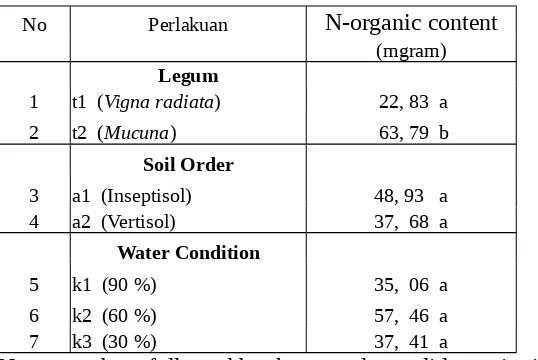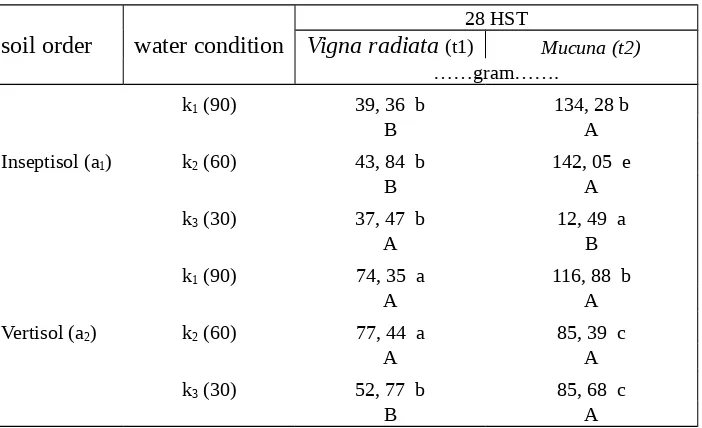THE ABILITY TO COMPETE OF ALLELOPATHY-PRODUCING PLANT TO OTHER PLANTS IN VARIOUS ENVIRONMENTAL CONDITIONS
Uum Umiyati,
ABSTRACT
The experiment was aimed to identify the effect of allelopathy-producing plant in competing chemically to other plants in various environmental conditions.
The experiment was done at a screen house with factorial randomized block design with three replication; the experiment used two genotypes of legume plants (t) (Vigna radiate L cultivar Sriti and Mucuna pruriens), two orders of soil (a) (Inseptisol and vertisol) and three water conditions (k) (30%, 60%, 90%). The result of observation was analyzed using F-test, if there was difference between treatments, it would be followed by Duncan test at level 5%.
The ability of plant to interact chemically by producing allechemistry was among other things influenced by the plant type. The difference in environmental condition (soil order and water condition) caused allelochemistry effect from both legume plants to be different. The allelopathy-producing plants (Vigna radiate L cultivar Sriti and Mucuna pruriens) which were chemically competed, influence directly the growth (root length and dry weight) of cucumber plant and indirectly the organic N content of plant, in which the influence level to various soil order and water condition showed difference.
Keywords: Allelopathy-producing plant, competing ability, allelochemistry, soil order, water condition and organic N content.
Introduction
There were several good allelopathy-producing type of plants from legume plants and several higher-level plants such as Accasia sp, Albazia lebbeck, and from weeds such as wide leaf weed, grass and sedge.
The allelopathy-producing legume plants were of the type Vigna radiata,Vigna unguiculata, Phaseolus vulgaris and Mucuna pruriens. While the allelopathy-producing gramineous plant were of the type Oryza sativa, Triticum sativum, Zea mays, Sorghum bicolor (Chou, 1986), but among those plants, we have not been able to identify to what extent its significance toward other plants or weeds.
The allelochemistry produced by green bean (Vigna radiata L) could directly or indirectly hamper or accelerate the growth and development of other organisms. The allelochemistry acted selectively, that is influencing certain type of organism but not toward other organism (Weston, 1996).
Micuna plant had the ability to produce allelopathy compound which could affect other plants near it and it could decrease nematodes underground. The chemical compounds produced by Mucuna include L-Dopa, where it could prevent the growth of wide leaf weed and grass-type weed (Camaal-Maldonado et al., 2001).
substance, becoming pest, wasting underground water and nutrient resource. Therefore the existence of weed in crop system should be controlled to prevent the disruption of plant growth and over-competition between plant and weed.
Rao (2000) explained that the intensity of competition between weed and horticultural plant depended on (1) the ability of plant to compete, (2) the species of weed and plant, (3) the length of weed intrusion, and (4) the climate condition which influenced the growth of weed and plant.
Vigna and Micuna consisted of several new cultivars or genotypes having various growth characteristics such as …, endurance against water and nutrient stress, endurance toward weed and disease and so forth. In agriculture ecosystem, the difference in the plant abilities caused difference in competing ability physically or chemically.
The difference in plant ability to compete chemically was caused by the difference in the growth and development phase, the content of organic matters in plant such as carbohydrate and protein, those differences made variations in producing allelopathy.
The existence of allelopathy could decrease or increase the productivity of soil that depended on the formation of allelopathy (plant or weed), target organism and its activities. Therefore, a research was needed to identify the ability of legume plant to compete with other plants in various condition of restricted abiotic environment.
The purpose of the research was to identify the extent of plant producing allelochemistry in competing with other plants.
Research Materials and Method
Materials and equipment for experiment
The experiment was done in pots arranged in screen house, from December 2007 to February 2008. The research used 3 factors, which were 2 types of legume plant (t) Vigna radiate L cultivar Sriti and Mucuna pruriens), two orders of soil (a) (Inseptisol and vertisol) and three water conditions (k) (30%, 60%, 90%). The research method used was group randomized design with factorial replicated three times. The data was then analyzed using analysis of variance (anova), if F calculated > F table at 5% level then the test would be followed by Duncan multiple range test at 5% level.
Result and Discussion
The different effects produced by the two species of legume plants used toward cucumber plant showed that, each species of plant have the ability to produce inhibitor substance or allelochemistry in various amount and type and with specific effect toward certain plant (Dakshini et al., 1999).
not influencing the growth process but on the growth and harvest, and the density of plants competing was increased.
The Root Length of Cucumber
Based on Table 2, the root length of cucumber at 14 DAP did not showed any interaction and there was no significant difference among treatments. According to Einhellig (1999), the ability of plant to interact chemically to produce allelochemistry was influenced, among other things, by the age of the plant. Therefore at 14 DAP, Vigna radiata plant or Mucuna produced toxic substance (allelochemistry) emitted through the root exudates was at low concentration that its inhibiting effect toward the growth of cucumber root was also low.
Table 2. The effect of two legume plant Vigna radiata (t1) and Mucuna (t2)] at different
soil order (a) and water condition (k) toward the root length of cucumber (Cm) at 14 DAP.
No Treatment root length (Cm) Legum
1 t1 (Vigna radiata) 9,77 a 2 t2 (Mucuna) 8,60 a
soil order
3 a1 (Inseptisol) 8, 88 a 4 a2 (Vertisol) 9, 49 a
water condition
5 k1 (90 %) 10,25 a
6 k2 (60 %) 7,77 a
7 k3 (30 %) 9,54 a
Note: Numbers followed by the same letter did not significantly differ at 5% level based on Duncan’s test.
In Table 3, it was seen that the water condition remained the same but at different soil order, the effect of allelochemistry from both legume plants would be different. Chou (1986) explained that soils with good drainage, was a good environment for the growth of soil microorganisms that would provide nutrients for plants, causing the amount of phytotoxicity of plant to be low so it would not inhibit the growth of root of other plants.
28 HST
legume plants
water
conditions Inseptisol (a1) Vertisol (a2)
…...Cm……. k1 (90) 20,75 a 15,05 b
A B
Vigna radiata (t1) k2 (60) 10, 95 c 13, 50 bc
A B
k3 (30) 9,10 c 10,70 d
A A
k1 (90) 13, 60 b 19, 25 a
A A
Mucuna (t2) k2 (60) 11, 00 c 11.60 cd
A A
k3 (30) 9,25 c 9, 5 0 d
B B
Note: The interaction between t × k × a was significantly tested. Numbers followed by the same letter was not significantly different according to Duncan’s test at 5% level. The capital letters should be read vertically and the small letters should be read horizontally.
Varnam (2000) stated that the presence of allelopathy from root exudates of green bean plant and Mucuna in Vertisol soil cause the available nitrogen source (NH4+)
to be attracted to organic acid at rhizosphere and to be immobile out of rhizosphere. The available nitrogen out of rhizosphere in the form of NO2- would easily be lost due to
evaporation and toxic to the root of cucumber plant that the plant root would be low.
The root length of two legume plant (Vigna radiata and Mucuna pruriens)
Table 4 showed that there was no interaction between the three factors tested. The root length of green bean and Mucuna at 14 DAP and 28 DAP showed difference. This was caused by the difference in morphology and physiology of both plant, but the difference in condition did not have significant effect toward Vigna radiata or Mucuna, indicating that Vigna radiata and Mucuna was a plant with highly adaptive plant, the condition could be one of the characteristics of plant’s ability to physically and chemically compete with other plants.
Until water condition of 30% at various soil types, the root length of Vigna radiata plant and Mucuna could actively grow long, to reach water sources in deep soil. According to Itoh et al. (1987) stated that the root extension which was still active in stressful water condition was related with the ability of plant in maintaining the turgidity of root cells which actively grow. The condition showed that both of legume plant was highly efficient plants which were able to compete by benefiting water stress condition.
Table 4. Root length (cm) of two legume plants (Vigna radiata and Mucuna) at different Soil order (a) and water condition at 14 and 28 DAP
14 HST 28 HST Legum
1 t1 (Vigna radiata) 9,34 a 14, 06 a 2 t2 (Mucuna) 18,02 b 23, 61 b
Soil order
3 a1 (Inseptisol) 13, 77 a 16, 37 a 4 a2 (Vertisol) 13, 59 a 21, 30 a
water condition
5 k1 (90 %) 16, 66 a 22, 75 a
6 k2 (60 %) 15, 54 a 17, 85 a
7 k3 (30 %) 11, 84 a 15, 90 a
Note: Numbers followed by same letters did not significantly differ at 5% level based on Duncan’s test
The presence of cucumber as an indicator plant did not give significant effect toward the root growth of green bean or Mucuna. According to Chou (1999), this was indicating a characteristic of allelochemistry effect of Vigna radiata or Mucuna that would cause population domination of green bean or Mucuna on a land.
Dry weight of Cucumber plant
The observation on dry weight of cucumber did not show any significant effect between treatments at age 14 DAP, because Vigna radiata or Mucuna pruriens competed at early age that the effect of allelochemistry given was at very low concentration that the effect toward the growth of indicator plant was low. The observation on dry weight of indicator plant at age 28 DAP started to show interactions between treatments. The range of water availability for plant was influenced by texture and organic matter content of soil. Vertisol soil had a clayish texture, poor drainage and aeration and average to high nutrients. Inseptisol soil had a loamy texture, good drainage and aeration but low nutrients cause it had been swept (Suyanto, 1993).
Table 5. The effect of two legume plants Vigna radiata (t1) and Mucuna (t2)) at different
soil order (a) and water condition toward dry weight of cucumber (Gram) at 14 DAP
No Treatment
dry weight of cucumber
(gram) Legum
1 t1 (Vigna radiata) 0, 56 a 2 t2 (Mucuna) 0, 44 a
soil order
3 a1 (Inseptisol) 0, 48 a
4 a2 (Vertisol) 0, 51 a
water condition
5 k1 (90 %) 0, 53 a
7 k3 (30 %) 0, 43 a
Note: the interaction between t × k × a was significantly tested. Numbers followed by the same letter was not significantly different according to Duncan’s test at 5% level.
The condition cause Mucuna which was plant alongside cucumber to have competition in absorbing water and nutrients causing Mucuna to emit secondary metabolite to inhibit the growth of cucumber plant by inhibiting the process of root splitting (pembelahan akar) that the root of the plant could not absorb water and nutrient to places far from the root zone. This had caused water and nutrient suply to higher part to be interrupted, disturbing the process of photosynthesis that the accumulation of dry matters to decrease. The condition could be seen at treatment a2k2t2 (0, 88 g).
The secondary metabolite or allelochemistry produced by Mucuna was L-DOPA to inhibit protein synthesis and photosynthesis, causing the dry weight of cucumber to be low and chlorosis at old leaf.
Table 6. The effect of two legume plants Vigna radiata (t1) and Mucuna (t2)] at different
soil order (a) and water condition (k) toward dry weight of cucumber (Gram) at 28 DAP
28 HST
soil order
water
condition Vigna radiata (t1) Mucuna (t2) …...Cm…….
k1 (90) 1, 99 c 2, 33 c
B A
Inseptisol (a1) k2 (60) 2, 28 b 1, 10 d
A B
k3 (30) 0, 91 a 2, 78 b
B A
k1 (90) 1, 23 e 2, 48 c
B A
Vertisol (a2) k2 (60) 2, 77 a 3, 26 a
B A
A B
Note: the interaction between t × k × a was significantly tested. Numbers followed by the same letter was not significantly different according to Duncan’s test at 5% level. The capital letters should be read vertically and the small letters should be read horizontally.
Dry weight of Green bean and Mucuna pruriens
Dry weight of Mucuna pruriens and Vigna radiata plant was significantly different at 14 DAP. This was caused by the age of the plant was still at vegetative phase, where at the phase, the water condition and type of soil should not have any significant effect toward the dry weight of the plant.
The condition was only influenced by the characteristics of both plants which differ to one another, such as the difference in the kernel size. Hale and Orcutt (1987) said that the plant’s characteristics such as the kernel size, the speed of germination, the size of leaf and rooting was the characteristics that would determine the ability of a plant to compete. Those characteristics would identify the efficiency and ability to compete of Vigna radiata and Mucuna in benefiting the limiting factors of environment.
Table 7. Dry Weight (Gram) of Vigna radiata (t1) and Mucuna (t2) at different soil order
(a) and water condition (k) at 14 DAP.
No Treatment Dry weight (gram)
Legum
1 t1 (Vigna radiata) 0, 53 a 2 t2 (Mucuna) 2, 22 b
Soil Ordo
3 a1 (Inseptisol) 1, 49 a 4 a2 (Vertisol) 1, 25 a
Water Condinitation
5 k1 (90 %) 1, 37 a
6 k2 (60 %) 1, 89 a
7 k3 (30 %) 0, 86 a
Note: values followed by the same letter did not significantly differ at 5% level based on Duncan’s test.
availability of underground water at reproductive phase compared to vegetative phase (Yusnaeni et al., 1999).
The Mucuna plant at 28 DAP (table 8) showed the highest dry weight at soil type of Inseptisol and water condition at 60% (a1k2t2). This showed that Mucuna was
very adaptive to humid soil of loamy type, with a good drainage and aeration in a soil pH of 5, 6. This condition was most appropriate to the development of Mucuna’s root in absorbing water and nutrients to be used for the growth of stem and leaf, causing the plant’s dry weight to be high (Webber et al., 1997).
It was another way around for green bean which showed high dry weight in vertisol and water condition of 60% (a1k2t1) which was 2.64 grams. The condition
indicated that Vigna radiata did not need too much water, because it would have a negative effect toward vegetative growth of green bean.
The growth variety of green bean and Mucuna tested showed the ability of each plant species in benefiting the limiting factor of environment and in dominating the growth environment.
Table 8. Dry weight (Gram) of Vigna radiata (t1) and Mucuna (t2) plant at different soil
order (a) and water condition (k) at 28 DAP
water condition
Legum Plants soil order k1 (90) k2 (60) k3 (30) …...Cm…….
1, 78 c 1, 23 d 1, 62 c
A B A
Vigna radiata (t1) Inseptisol (a1) 1, 57 c 2, .64 b 1, 69 c
B A B
5, 58 a 8, 67 d 4, 11 a
Mucuna (t2) Vertisol (a2) B A C
3, 87 b 1, 60 c 3, 62 b
A B A
Note: the interaction between t × k × a was significantly tested. Numbers followed by the same letter was not significantly different according to Duncan’s test at 5% level. The capital letters should be read vertically and the small letters should be read horizontally.
According to Taylor (2002), in a small community, allelochemistry interaction produced by a plant could be a regulating dominating factor, so that green bean and Mucuna had the ability to interact chemically by having allelochemistry content of C-glycosyl flavonoid (green bean) and L-DOPA (Mucuna) to reduce the vegetative growth of cucumber plant.
At table 9, it could be seen that N organic in cucumber at 14 DAP was not influenced by the existence of allelopathy plant (allelopathy producer). This was because 14 DAP was a good initial phase of vegetative for Vigna radiata, Mucuna and also cucumber that the chemistry competition in absorbing nitrogen could not be seen yet. The view was in accordance with Eussen (1980) which stated that the amount of nitrogen absorbed by plant depend on age, species, density and the type of soil used.
The different type of soil would give different effects toward the nutrient content, pH and microorganism activities, so that the plant response toward nutrient would also be different and influenced the percentage of nutrient in plant.
Inseptisol soil had a good aeration and drainage that the microorganism activity was better compared to Vertisol soil and the availability of nutrient for plant would also be higher.
Table 9. The effect of two legume plants Vigna radiata (t1) and Mucuna (t2)] at different
soil order (a) and water condition (k) Cucumber N-organic content (mgram) of cucumber at 14 DAP
No Treatment
Cucumber N-organic content
(mgram) Legum
1 t1 (Vigna radiata) 15, 97 a 2 t2 (Mucuna) 18, 94 a
soil order
3 a1 (Inseptisol) 23, 19 b 4 a2 (Vertisol) 11, 72 a
water condition
5 k1 (90 %) 20, 29 a
6 k2 (60 %) 16, 06 a
7 k3 (30 %) 16, 01 a
Note: values followed by the same letter did not significantly differ at 5% level based on Duncan’s test.
According to Robertson and Vitousek (1981), the chemical interaction between
Vigna radiata or Mucuna with cucumber had made nitrogen to be unavailable for
cucumber because the inhibition of nitrification process by inhibiting bacterial activity of nitrosomonas which provide nitrogen. Therefore the dry weight and N-organic content of cucumber was low.
At 28 DAP, the content of N-organic of cucumber did not show significant difference between treatments a2k3t2, a1k3t1 and a2k3t1. According to Yang et al. (2004),
Table 10. the effect of two legume plants Vigna radiata (t1) and Mucuna (t2)] at different
soil order (a) and water condition (k) toward N-organic content (mGram) at 28 DAP
28 HST
legume plants water condition Inseptisol (a1) Vertisol (a2)
……gram……. k1 (90) 20, 45 f 35, 51 c
B A
Vigna radiata (t1) k2 (60) 40, 40 c 43, 71 b
A A
k3 (30) 25, 74 e 25, 84 e
B A
k1 (90) 63, 51 a 45, 58 b
A B
Mucuna (t2) k2 (60) 51, 13 b 62, 44 a
A A
k3 (30) 34, 21 d 14, 80 e
B B
Note: the interaction between t × k × a was significantly tested. Numbers followed by the same letter was not significantly different according to Duncan’s test at 5% level. The capital letters should be read vertically and the small letters should be read horizontally.
The insufficient water condition along with Inseptisol or Vertisol made nutrient’s solubility to be low. According to Handayanto et al. (2007), the fact cause a chemical interaction by releasing allelopathy through exudate of the root of Vigna radiata or
Mucuna to the rhizosphere area to inhibit the process of oxidation of NH4+ to be NO3-.
NH4+ was join by carboxylic acid secreted by green bean and Mucuna so that it could
not move out of rhizosphere area of the root of Vigna radiata and Mucuna, the nitrogen
element outside of rhizosphere in the form of NO2- was easily evaporate that it could not
be benefited by the root of cucumber plant.
The difference in soil order and water content did not show any effect toward the N-organic content of Vigna radiata and Mucuna at 14 DAP (Table 10). This was because
between green bean and Mucuna had different characteristics, especially the size of product storage or the size of kernel. The condition caused Mucuna at early vegetative phase to have a lot of N-organic stored in its tissue. This view was supported by Holzner and Numata (1982) that the protein content stored in kernel was in great quantities showing the ability of plant to compete that in the beginning of its growth, the plant could meet the nutrient demand of its own.
According to Dixon and Whiller (1983), the contribution of environment to the difference in plant population was influenced by the variation of source and the use of nitrogen by the plant and variation in pH. pH had an effect on the activity of soil microorganisms. Sarief (1989) stated that soil with pH neutral would support the growth of microorganisms.
Table 11. N-organic content (mGram) of Vigna radiata (t1) and Mucuna (t2)
No Perlakuan N-organic content (mgram)
Legum
1 t1 (Vigna radiata) 22, 83 a 2 t2 (Mucuna) 63, 79 b
Soil Order
3 a1 (Inseptisol) 48, 93 a 4 a2 (Vertisol) 37, 68 a
Water Condition
5 k1 (90 %) 35, 06 a
6 k2 (60 %) 57, 46 a
7 k3 (30 %) 37, 41 a
Note: numbers followed by the same letter did not significantly differ at 5% level based on Duncan’s test.
But, at pH less than 5.5, the growth of microorganism would be hampered. The range of pH of soil used in the second experiment was 5.6 for Inseptisol and 6.8 for Vertisol soil, so that the N-organic content between green bean and Mucuna in both land showed differences.
The difference in nitrogen usage caused variation in nitrogen content at plant tissue of Vigna radiata or Mucuna or cucumber. Dixon and Whiller (1983) said that the
In addition, allelopathy secreted through root exudates of Vigna radiata in the form
of HCN inhibit the protein synthesis as indicated by the inhibition of root length so that the absorption of nutrient especially nitrogen to be inhibited, causing dry weight of plant and N-organic content of cucumber to be low and cucumber leaves were having chlorosis (Einhellig, 2004).
Table 12. The content of N-organic (mGram) of Vigna radiata (t1) and Mucuna (t2) at
different soil order (a) and water condition (k) at 28 DAP
28 HST
soil order water condition Vigna radiata (t1) Mucuna (t2)
……gram…….
k1 (90) 39, 36 b 134, 28 b
B A
Inseptisol (a1) k2 (60) 43, 84 b 142, 05 e
B A
k3 (30) 37, 47 b 12, 49 a
A B
k1 (90) 74, 35 a 116, 88 b
A A
Vertisol (a2) k2 (60) 77, 44 a 85, 39 c
A A
k3 (30) 52, 77 b 85, 68 c
B A
Note: the interaction between t × k × a was significantly tested. Numbers followed by the same letter was not significantly different according to Duncan’s test at 5% level. The capital letters should be read vertically and the small letters should be read horizontally.
The opinion was supported by Orcutt (2000), that allelochemistry secreted by plant species could affect the nutrition cycles in an ecosystem to finally influence the diversity of population in the ecosystem.
Conclusion
The ability of green bean (Vigna radiata) cultivar Sriti and Mucuna pruriens (karo bendo) to interact chemically in a shortage of growth factor condition to secrete C-glykosil flavonoid (Vigna radiata) and L-DOPA (Mucuna pruriens) directly influenced the growth of plant and indirectly influenced the availability of nitrogen in soil.
DAFTAR PUSTAKA
Chou, C. H. 1999. Role Allelopathy in Plant Biodeversity and Sustainable Agriculture. Critical Reviews in Plant Sciences. 18. 609-636.
_________. 1986. The Role of Allelopathy in Subtropical Agroecosystems in Taiwan. In Putnam, A. R. and C. S. Tang (eds). The Science of Allelopathy . New York. John Wiley and Sons.
Dakshini, K. M. M. Inderjit and Foy, C. L. 1999. Allelopathy One Component in a Multifacetet Approach to Ecology. In Inderjit , K. M. M. Inderjit and Foy, C. L (eds)nPrinciples and Practices in Plant Ecology Allelochemical Interactions. Boca Toton. CRC Press.
Dixon, R. O. D; and Wheller, C. T. 1983. Biochemical, Physiologicals and Enveronmental. Aspect of Symbiotic Nitrogen Fixation. In Gordon , J. C; and Wheeler , C. T. Ed. Biological Nitrogen Fixation in Forest Ecosystem Foundations and Applications. Martinus Nijhoff. The Hague. 107-171.
Einhellig, F.A. 1999. An Integrated View of Phytochemicals Amid Multiple Stresses. Principles and Practices in Plant Ecology; Phytochemicals Interactions (Eds. Inderjit, K. M. M. Dakshini and C. L. Foy). Pp. 479-494. CRC Press, Boca Raton.
_____________. 2004. Mode of Allelochemical Action of Phenolic Compounds. In Allelopathy Chemistry and Mode of Action of Allelochemical. CRC. Press, P. 217-238. Edited by Mocia. Eussen. 1980. Weeds in Upland Rice. VI. Competition between Rice and Ageratum conyzoides L. In
Replecement Series. Biotrop Nuffic.
Foy, C. L. 1999. How to Make Bioassays for Allelopathy More Relevant to Field Conditions with Particular Reference to Eropland Weeds. In Inderjit K. M. M. Dakshini and C. L. Foy (eds) Principles and Practices In Plant Ecology Allelochemical Interactions. Boca Raton. CRC Pres. Handayanto, E dan Hairiah, K. 2007. Landasan Pengelolaan Tanah Sehat. Biologi Tanah. Pustaka
Adipura. Yogyakarta.
Hale, M. G. and D. M. Orcutt. 1987. The Physiology of Plant Under Stress. A Willey Interscience Publication Jhon Wiley & Sons. New York. Hal 11-15.
Holzner, W and M. Numata. 1982. Biology and Ecology of Weeds. Dr. W. Junk Publishers The Hague-Boston- London.
Itoh, K, K. Nakahara, H. Ishikawa, E. Ohta and M. Sakata. 1987. Osmotic Adjustment and Osmotic Constituents in Roots of Mungbean Seedlins. Plant Cell Physiol. 27 : 1445-1450.
Naylor, R. E. L. 2002. Weed Management Handbook. Ninth Edition. Bleckwell Science.
Orcutt, M. D., and Erik T. Nilsen. 2000. The Physiology of Plants Under Stress. John Wiley and Sons. Inc. Ney York.
Rao, V. S. 2000. Principles of Weed Science. 2nd ed. Science Publishers. Inc., New Hampshire, USA.
Robertson, G. P. and Vitousek, P. M. 1981. Nitrification Potential in primary and secondary Succession. Ecology, 63. 1561-1573.
Sarief, E. S. 1989. Fisika – Kimia Tanah Pertanian. CV. Pustaka Buana. Bandung.
Suyamto, H. 1993. Hara Mineral dan pengelolaan Air pada Tanaman Kacang Tanah. P. 108-137. dalam
Taiz, L and Zeiger, E. 2006. Plant Physiology Sinaver Associates, Inc, Publisers. Sunderland. Massachusetts. Fourth Edition.
Temple, S. R. and L. M. Huyck. 2004. Genetic Improvement of Mucuna to Reduce antinutritional Factor and its Ecological Significance. University of california, davis, CA, USA.
Varnam, A. H. 2000. Environmental Microbiology. Manson Publishing. London.
Webber, G. K., Robert, A. B., and Carsky, J. R. 1997. Handbook for USE of Llexsys (Legum Expert System); Decision Support for Integreting Herbaceous Legum Intro Farming System. International Institute of Tropical Agriculture. Nigeria. 31 p.
Weston, L. A. 1996. Utilization of Allelopathy for Weed Management in Agrosystem. Agronomy Journal. 88:6. 860-866.
Yang, C. M., M. C. Wang., I. F. Chang, and C. H. Chou. 2004. Humic Substances Affect The Activity of Chlorophyllase. J. Chem. Eco. 30: 1051-1059.
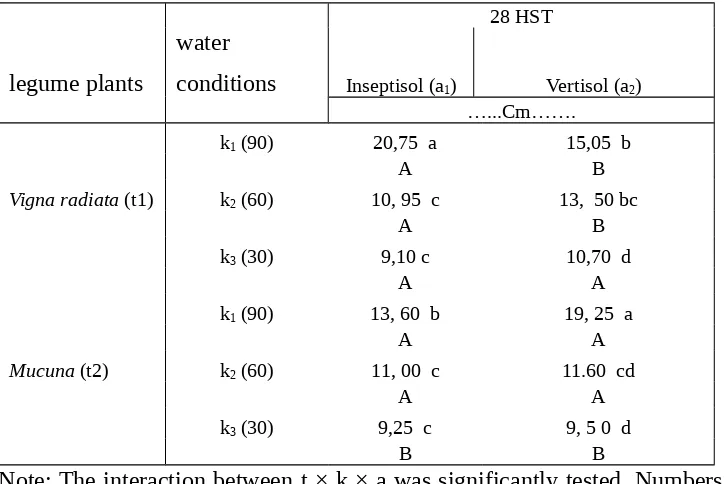
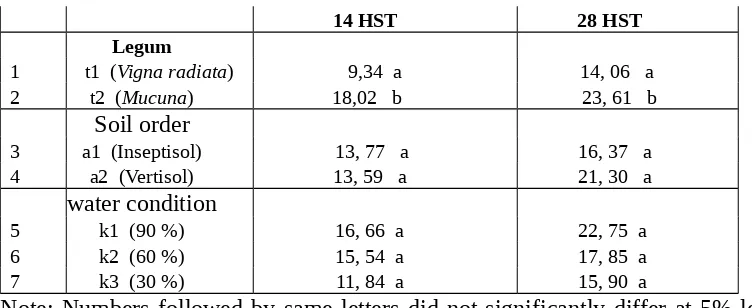
![Table 6. The effect of two legume plants Vigna radiata (t1) and Mucuna (t2)] at differentsoil order (a) and water condition (k) toward dry weight of cucumber (Gram)at 28 DAP](https://thumb-ap.123doks.com/thumbv2/123dok/497909.139661/6.595.92.507.526.750/table-effect-radiata-mucuna-differentsoil-condition-weight-cucumber.webp)
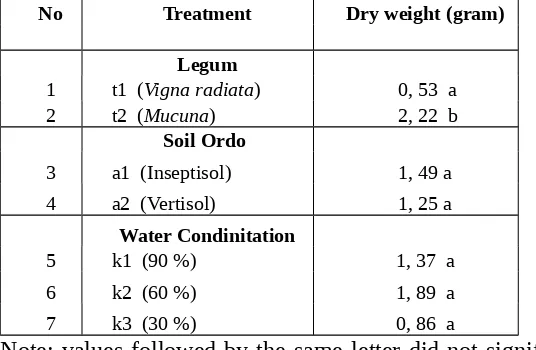
![Table 9. The effect of two legume plants Vigna radiata (t1) and Mucuna (t2)] at differentsoil order (a) and water condition (k) Cucumber N-organic content (mgram) ofcucumber at 14 DAP](https://thumb-ap.123doks.com/thumbv2/123dok/497909.139661/9.595.108.460.304.551/radiata-mucuna-differentsoil-condition-cucumber-organic-content-ofcucumber.webp)
![Table 10. the effect of two legume plants Vigna radiata (t1) and Mucuna (t2)] at differentsoil order (a) and water condition (k) toward N-organic content (mGram) at28 DAP](https://thumb-ap.123doks.com/thumbv2/123dok/497909.139661/10.595.70.425.263.512/table-legume-radiata-mucuna-differentsoil-condition-organic-content.webp)
